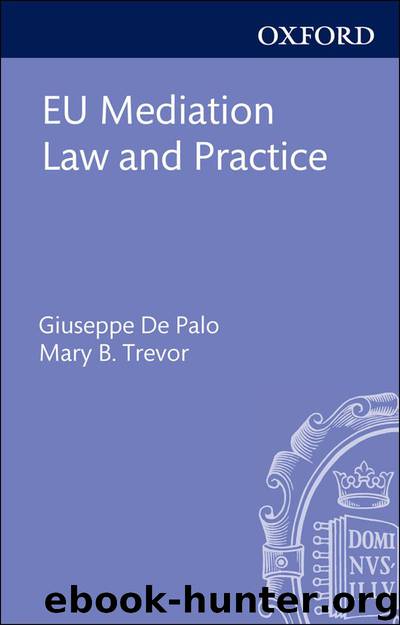EU Mediation Law and Practice by Giuseppe De Palo & Mary B. Trevor

Author:Giuseppe De Palo & Mary B. Trevor [De Palo, Giuseppe]
Language: eng
Format: azw3
Publisher: OUP Oxford
Published: 2012-10-04T04:00:00+00:00
6. Requirements for Parties and Lawyers to Consider Mediation as a Dispute Resolution Option
23.25 As noted above, before litigation starts, the judge may ask the parties if they are willing to resolve the dispute by conciliation, in which the judge tries to reconcile the parties and bring them to a mutually agreeable decision. However, this procedure cannot be considered mediation, because it lacks the typical features of the mediation process.
23.26 Alternatively, the judge may also recommend that the parties participate in mediation; should they do so, a separate and independent mediator handles the case. The lawyers cannot interfere with the decision of the parties to mediate their dispute. It is always the parties that choose the mediator. The judge only informs them about the public availability of the list of mediators on the website of the Ministry of Justice (the ‘Ministry’) of the Slovak Republic.
23.27 A motivation for turning to mediation and concluding a mediation agreement, even after the initiation of a trial, is the potential for the reimbursement of certain costs. If the court recommends mediation and a litigant, without good reason, refuses to attend the first meeting with a mediator, the court may refuse to completely or partially reimburse the litigant for litigation costs, even if such reimbursement might have been otherwise available.
Download
This site does not store any files on its server. We only index and link to content provided by other sites. Please contact the content providers to delete copyright contents if any and email us, we'll remove relevant links or contents immediately.
The Thirst by Nesbo Jo(5788)
Permanent Record by Edward Snowden(5002)
The Myth of the Strong Leader by Archie Brown(4792)
Spare by Prince Harry The Duke of Sussex(4203)
A Higher Loyalty: Truth, Lies, and Leadership by James Comey(4035)
Secrecy World by Jake Bernstein(3786)
Adulting by Kelly Williams Brown(3674)
The Borden Murders by Sarah Miller(3591)
Fear by Bob Woodward(3260)
Killers of the Flower Moon by David Grann(3249)
The Last Girl by Nadia Murad(3057)
The Secret Barrister by The Secret Barrister(3009)
Future Crimes by Marc Goodman(3002)
American Kingpin by Nick Bilton(2973)
Liar's Poker by Michael Lewis(2814)
The House on Mango Street by Sandra Cisneros(2777)
Graduate Admissions Essays, Fourth Edition: Write Your Way into the Graduate School of Your Choice (Graduate Admissions Essays: Write Your Way Into the) by Asher Donald(2478)
Delicious Torment by Linsey Lanier(2448)
Camino Island by John Grisham(2387)
